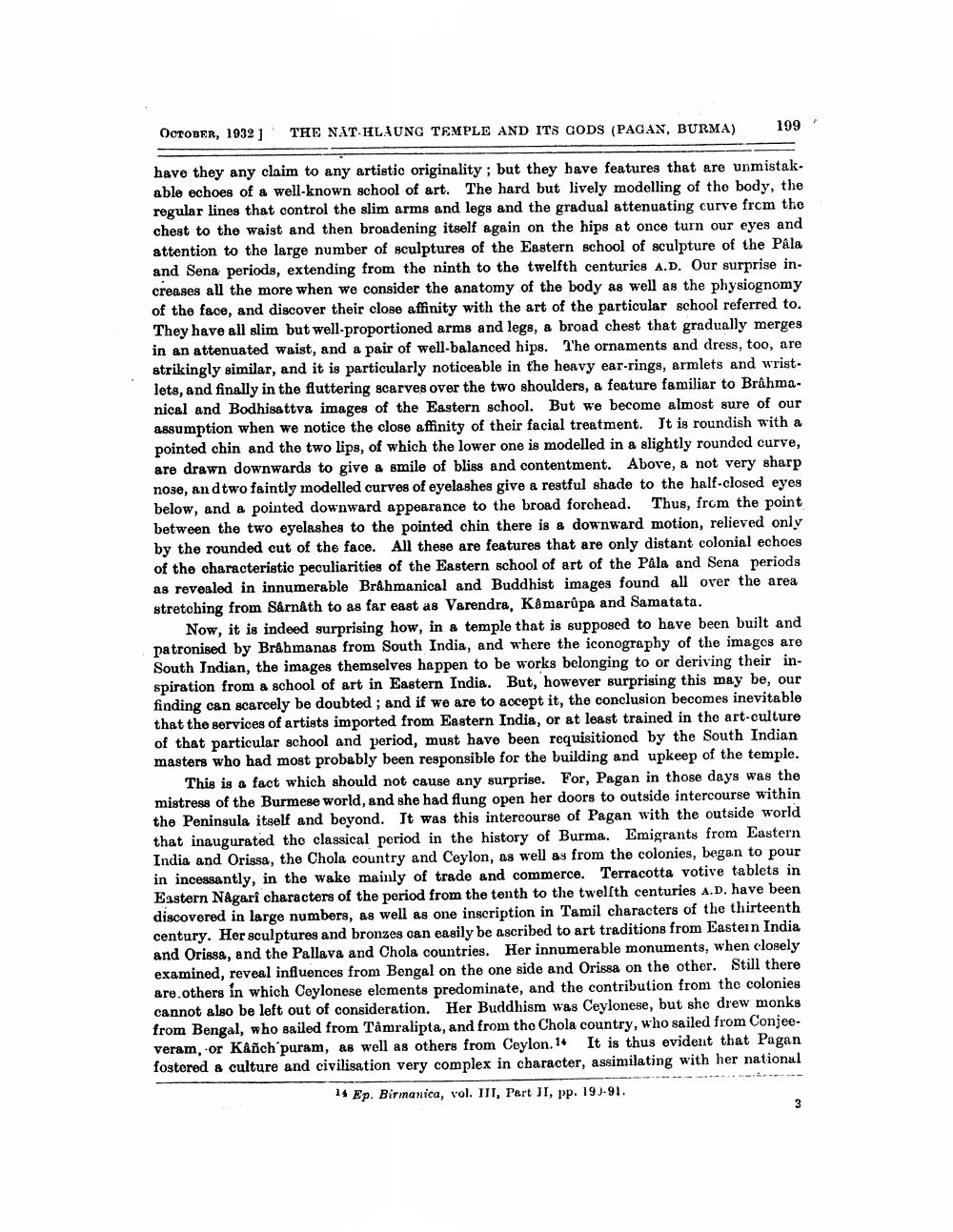________________
OCTOBER, 1932]
THE NAT-HLAUNC TEMPLE AND ITS GODS (PAGAN, BURMA)
199
have they any claim to any artistic originality ; but they have features that are unmistak. able echoes of a well-known school of art. The hard but lively modelling of the body, the regular lines that control the slim arms and legs and the gradual attenuating curve from the chest to the waist and then broadening itself again on the hips at once turn our eyes and attention to the large number of sculptures of the Eastern school of sculpture of the Pala and Sena periods, extending from the ninth to the twelfth centuries A.D. Our surprise in. creases all the more when we consider the anatomy of the body as well as the physiognomy of the face, and discover their close affinity with the art of the particular school referred to. They have all slim but well-proportioned arms and legs, a broad chest that gradually merges in an attenuated waist, and a pair of well-balanced hips. The ornaments and dress, too, are strikingly similar, and it is particularly noticeable in the heavy ear-rings, armlets and wrist. lets, and finally in the fluttering scarves over the two shoulders, a feature familiar to Brâhmanical and Bodhisattva images of the Eastern school. But we become almost sure of our assumption when we notice the close affinity of their facial treatment. It is roundish with a pointed chin and the two lips, of which the lower one is modelled in a slightly rounded curve, are drawn downwards to give a smile of bliss and contentment. Above, a not very sharp nose, and two faintly modelled curves of eyelashes give a restful shade to the half-closed eyes below, and a pointed downward appearance to the broad forehead. Thus, from the point between the two eyelashes to the pointed chin there is a downward motion, relieved only by the rounded cut of the face. All these are features that are only distant colonial echoes of the characteristic peculiarities of the Eastern school of art of the Pala and Sena periods as revealed in innumerable Brahmanical and Buddhist images found all over the area stretching from Sarnath to as far east as Varendra, Kamarûpa and Samatata.
Now, it is indeed surprising how, in a temple that is supposed to have been built and patronised by Brahmanas from South India, and where the iconography of the images are South Indian, the images themselves happen to be works belonging to or deriving their inspiration from a school of art in Eastern India. But, however surprising this may be, our finding can scarcely be doubted, and if we are to accept it, the conclusion becomes inevitable that the services of artists imported from Eastern India, or at least trained in the art-culture of that particular school and period, must have been requisitioned by the South Indian masters who had most probably been responsible for the building and upkeep of the temple.
This is a fact which should not cause any surprise. For, Pagan in those days was the mistress of the Burmese world, and she had flung open her doors to outside intercourse within the Peninsula itself and beyond. It was this intercourse of Pagan with the outside world that inaugurated the classical period in the history of Burma. Emigrants from Eastern India and Orissa, the Chola country and Ceylon, as well as from the colonies, began to pour in incessantly, in the wake mainly of trade and commerce. Terracotta votive tablets in Eastern Nagari characters of the period from the tenth to the twelfth centuries A.D. have been discovered in large numbers, as well as one inscription in Tamil characters of the thirteenth century. Her sculptures and bronzes can easily be ascribed to art traditions from Eastern India and Orissa, and the Pallava and Chola countries. Her innumerable monuments, when closely examined, reveal influences from Bengal on the one side and Orissa on the other. Still there are others in which Ceylonese elements predominate, and the contribution from the colonies cannot also be left out of consideration. Her Buddhism was Ceylonese, but she drew monks from Bengal, who sailed from Tâmralipta, and from the Chola country, who sailed from Conjeeveram, .or Kanch'puram, as well as others from Ceylon. 14 It is thus evident that Pagan fostered a culture and civilisation very complex in character, assimilating with her national
14 Ep. Birmanica, vol. III, Part II, pp. 19)-91.




